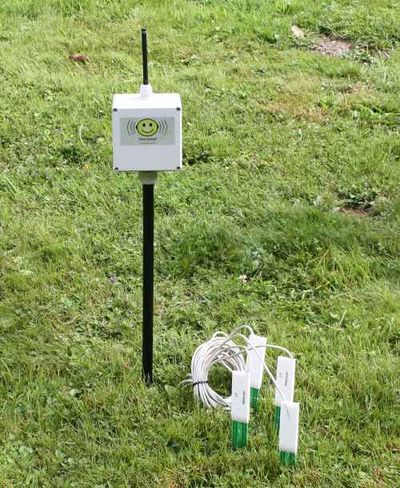Difference between revisions of "Wireless sensor network - Smilenet"
| (5 intermediate revisions by the same user not shown) | |||
| Line 1: | Line 1: | ||
| − | [[Image:image1 | + | [[Image:image1.jpg|right|400px|Wireless sensor network - image 2]] |
| − | |||
Wireless sensor network | Wireless sensor network | ||
| Line 7: | Line 6: | ||
===Summary:=== | ===Summary:=== | ||
| + | Smilenetz means Soil Moisture Intelligent Long-Range Environmental Network | ||
===Radio frequency used:=== | ===Radio frequency used:=== | ||
| − | + | 868 MHz and 2.4 GHz | |
===Radio protocol used:=== | ===Radio protocol used:=== | ||
| Line 20: | Line 20: | ||
300 m wet forest | 300 m wet forest | ||
| − | 868 MHz | + | at 868 MHz with 300 mW and quarter wave antenna |
| − | |||
| − | |||
| − | |||
===Hop modes:=== | ===Hop modes:=== | ||
| − | Point-to-multipoint | + | Point-to-multipoint or Zigbee dependent on |
| − | + | radio module | |
| − | |||
===GPRS:=== | ===GPRS:=== | ||
| − | + | GPRS modem at gateway | |
===Mesh limitations:=== | ===Mesh limitations:=== | ||
| − | |||
| − | |||
| − | |||
| − | |||
| − | |||
| − | |||
| − | |||
| − | |||
| − | |||
| − | |||
| Line 64: | Line 50: | ||
Frequency counter | Frequency counter | ||
| − | Future: I2C, | + | RS232 |
| + | |||
| + | Future options: SDI12, I2C, SPI | ||
| Line 81: | Line 69: | ||
Data format: plain ASCII text file | Data format: plain ASCII text file | ||
| + | |||
| + | Future option: database | ||
===Power consumption:=== | ===Power consumption:=== | ||
| Line 92: | Line 82: | ||
Active mode with radio RX: 50 mA | Active mode with radio RX: 50 mA | ||
| − | Active mode with radio TX: 150 mA | + | Active mode with high power radio TX: 150 mA |
| Line 110: | Line 100: | ||
Range test in field, handheld radio for communication | Range test in field, handheld radio for communication | ||
| + | |||
| + | Monitoring software for incoming packets including RSSI | ||
| Line 195: | Line 187: | ||
Other related web sites: | Other related web sites: | ||
| − | Technical information | + | Technical information: http://www.mx.hs-mannheim.de |
Distributors | Distributors | ||
Latest revision as of 18:47, 13 June 2010
Wireless sensor network
Method:
Summary:
Smilenetz means Soil Moisture Intelligent Long-Range Environmental Network
Radio frequency used:
868 MHz and 2.4 GHz
Radio protocol used:
Range/Power (line of sight/dBm):
20 km line of sight
300 m wet forest
at 868 MHz with 300 mW and quarter wave antenna
Hop modes:
Point-to-multipoint or Zigbee dependent on radio module
GPRS:
GPRS modem at gateway
Mesh limitations:
Additional information:
Sensor compatibility:
1 Wire
Digital IO
8 channel 10 bit AD converter, 0 to 2.5V
Frequency counter
RS232
Future options: SDI12, I2C, SPI
Data reading frequency:
Adjustable, e.g. 30 s, 1 min, 15 min
Storage of data/backup:
SD card on node (e.g. 2 GByte)
CF card on Gateway (4 GByte)
Server with database on Internet
Data format: plain ASCII text file
Future option: database
Power consumption:
Sleep mode: about 40 uA
Active mode without radio/sensor: 8 mA
Active mode with soil moisture sensor: 50 mA for 400 ms
Active mode with radio RX: 50 mA
Active mode with high power radio TX: 150 mA
Reliability:
Years in service: 1 year
Failure rate instrument (years):
Packet failure (%): Depends on environment
Installation procedure:
Configuration in lab
Power on
Range test in field, handheld radio for communication
Monitoring software for incoming packets including RSSI
Installation underground possible:
yes
Battery life:
1 min interval: 2 weeks
90 min interval: approx. 2 years
Battery type
4x AA, 6V (5.2 V)
Sanyo Eneloop NiMh rechargeable, 2000 mAh, self discharge about 15% in 1 year
Alkalines as well (solar power optional in future)
Maintenance required /Ease of maintenance:
Change of battery required
Support:
Yes, but research institution
Software debug: Monitor mode to see all raw data, over the air programming in future
Software:
Web friendly interface:
Yes, Webpage with graphics based on Gnuplot
Data base:
No, future optional
Scripting language:
No, future optional
Update in the field:
Yes, but only with wired connection, wireless update is future option
Open source:
Yes (Linux, gnuplot, mysql)
Cost (non profit):
30 Euro microcontroller board
15 to 50 Euros radio (depending on frequency and power)
Gateway: 135 Euro embedded pc +30 to 65 Euro for radio modem
GPRS: 150 Euro
Communication costs: 0.2 Euro for 1 MByte
What to watch out for:
Problems/Questions:
Links
Projects that used the above equipment:
Other related web sites:
Technical information: http://www.mx.hs-mannheim.de
Distributors
